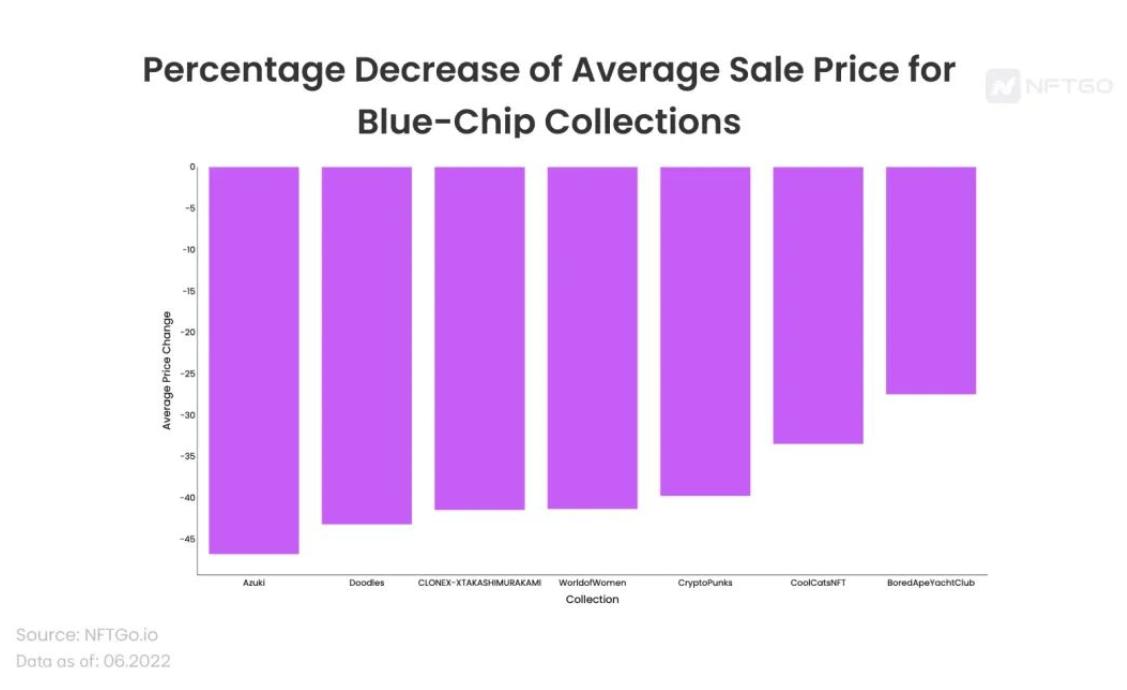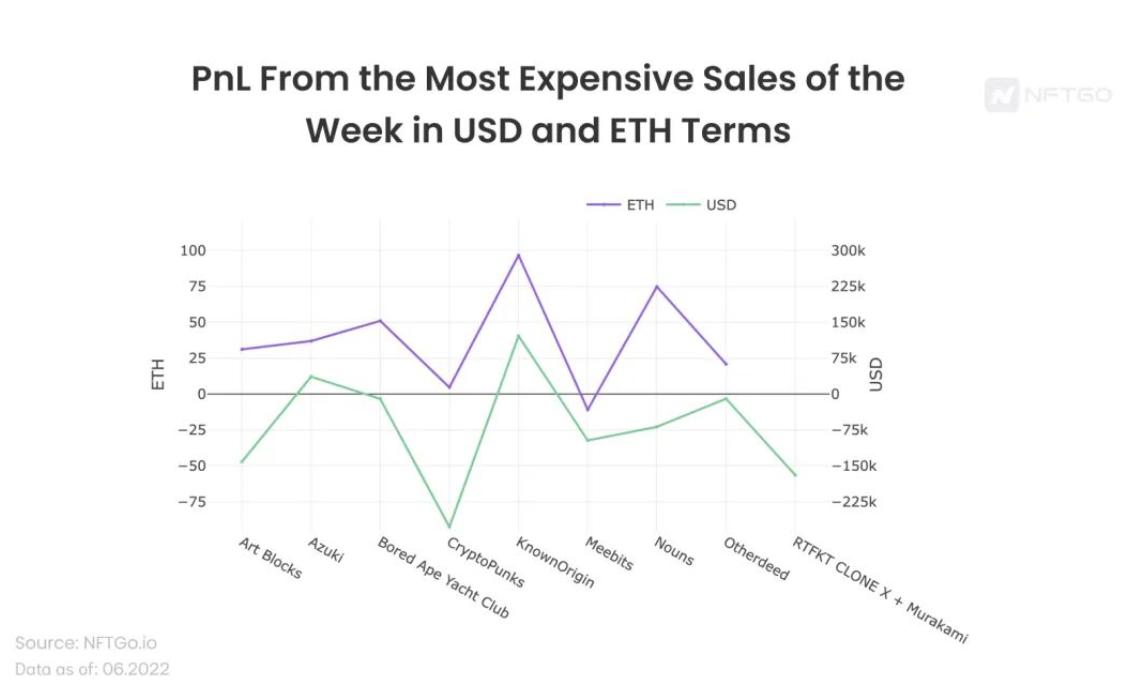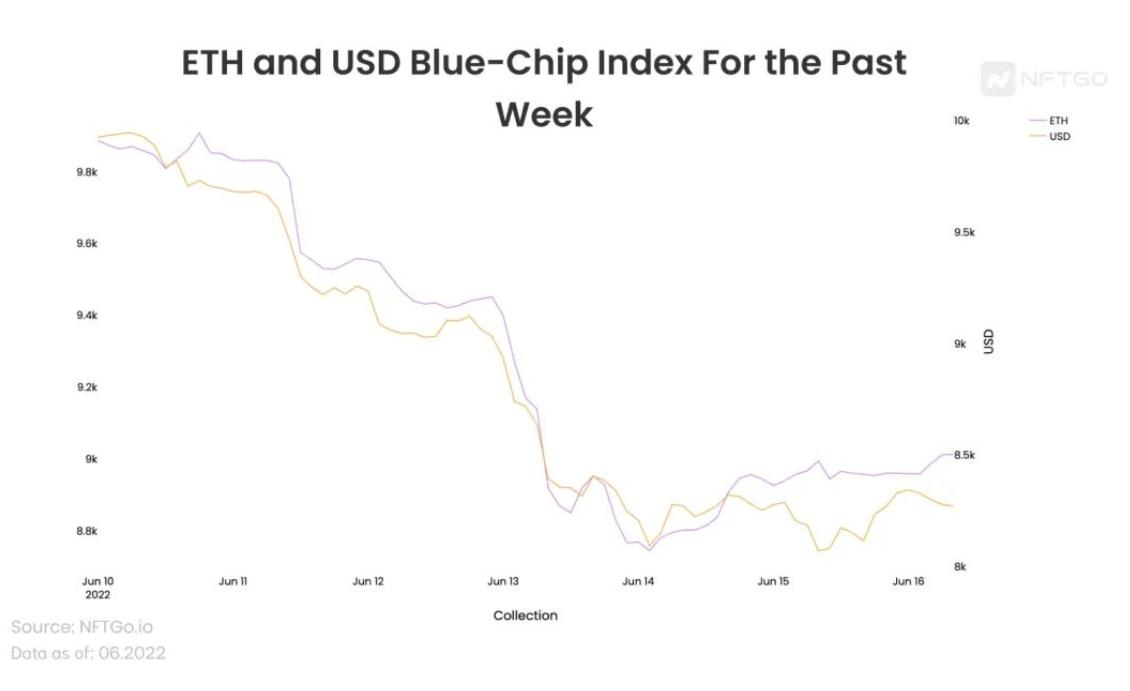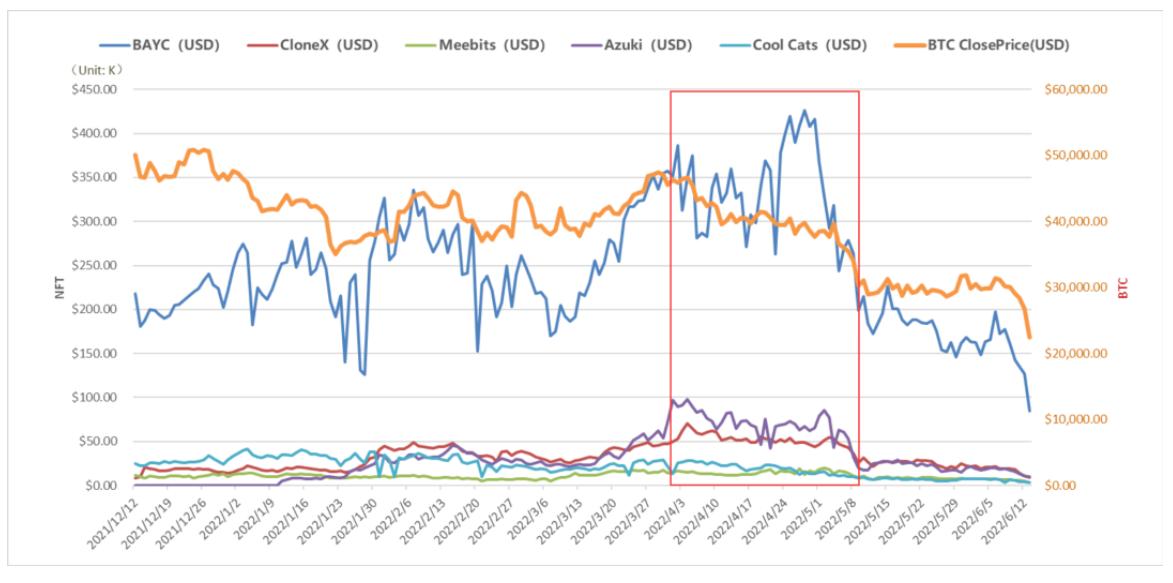Bear Market Special: Current Trends of Blue-Chip NFTs in the Market
Author: NFTGo
Bear Market Arrives
Recently, the Federal Reserve has continuously raised interest rates, LUNA and Celsius have experienced flash crashes, and events related to regulation and the correlation between the stock market and securities market have led to significant volatility in various assets in the market.
The most valuable and promising blue-chip NFTs, as commonly recognized in the market, have rapidly declined over the past week. Since the NFT market is primarily priced in ETH, and its price has continued to drop close to 1000 USDT over the past week, the valuation of NFTs has also fallen at an unprecedented speed. In this bear market series, we will analyze the market from multiple aspects, including the performance of blue-chip NFTs, who is bottom-fishing, the correlation of the crypto market, and whale tracking. In Series #1, we will focus on:
Which blue-chip NFTs are more resilient?
How much loss have investors suffered after buying million-dollar NFTs at the peak of the cycle?
The correlation between blue-chip NFTs and the trends of ETH and BTC.
We let the data speak, exploring the hidden trends in the NFT market from multiple perspectives.
Responding to the Plunge
In the past year, although the NFT market has experienced an unprecedented bull market cycle, the development of NFTs is still in its early stages, with the potential to return to historical highs or even exceed them.
To assess the performance of NFTs in the current bear market cycle, we have listed three data phases that can reflect market sentiment.
1- April 2022: The bear market cycle of cryptocurrencies continues, with prices continuously declining. Some analysts still refer to it as a Crab Market (volatile but without significant upward or downward trends). The Russia-Ukraine war and the Federal Reserve are the main factors affecting cryptocurrency prices.
2- May 2022: The price crash of LUNA accelerated the bear market cycle of cryptocurrencies.
3- Current Phase: Experiencing the largest bear market of the first half of 2022, with prices plummeting and some holders beginning to liquidate their assets.
The cooling market sentiment has greatly affected the average price of NFTs. Previously, during the most fervent phase, some blue-chip NFTs reached their peak valuations. Since then, these valuations have continued to plummet, entering a cooling cycle.
The following chart shows the changes in the average dollar price of NFTs from April to May 2022, compared to the current average dollar price. It is evident that the downward trend in the NFT market is still ongoing. From the first market crash in early May, when UST depegged and LUNA's price plummeted, to the current bear market phase that began in early June.

(Source: NFTGo.io)
The table below shows the decline in NFT prices under the impact of the cryptocurrency market. Although some NFTs are more resilient than others, the overall trend is still downward. Holders are willing to incur losses ranging from 46% to 27% to sell their blue-chip NFTs. On average, blue-chip NFT holders have lost 40% more when selling in June compared to April. The following chart shows the decline in average prices of different NFT projects from April to June.

(Source: NFTGo.io)
High-Value NFTs Sold at a Loss
In terms of transaction volume in the NFT market, blue-chip NFTs have always held a major advantage, and now some blue-chip NFTs are being traded at a loss. The real-time leaderboard of high-value transactions on NFTGo reflects the most expensive NFTs sold over a period. The following chart shows the distribution of NFT categories in the weekly sales leaderboard.

(Source: NFTGo.io)
It can be seen that BAYC accounts for the largest share in the NFT trading rankings. In the past week, over 85% of high-value transactions came from BAYC. Following BAYC is CryptoPunks, which accounts for about 3% of the total. BAYC's dominance is both bearish and bullish for itself.
We found that investors are trying to buy BAYC during the bear market. While the buying volume of other projects is relatively quiet, BAYC still dominates the real-time leaderboard for high-value NFT transactions.
However, the ensuing question is, what is the cost for these holders to sell high-value blue-chip NFTs? We first studied the average profit and loss of the top 200 transactions by price over the past week. To further illustrate the impact of ETH price declines on market valuations, we also created a profit and loss table (PnL) in both ETH and USD, calculated by subtracting the purchase price from the selling price.
The data shows that although the average profit in ETH terms is high, the profits in USD terms are either negative or very small compared to the general positive returns in ETH. This is a disturbing signal for all NFT holders, as this situation indicates that some holders are willing to incur additional USD losses to liquidate their NFT assets, and "panic selling" is generally one of the main signals of an impending winter.

(Source: NFTGo.io)
Blue-Chip NFTs VS ETH
Many blue-chip NFTs have seen their dollar prices decline in sync with ETH prices. As shown in the table below, the average selling prices of NFTs in both ETH and USD have shown significant declines.

Average ETH and USD prices of high-value NFTs over the past week (Source: NFTGo.io)
The number of active whales and the blue-chip NFT index over the past month indicate that whales are slowing down their trading activities in NFTs. Whales are the most capitalized players in the NFT market, driving market liquidity and most large-scale trading activities. When the number of active whales begins to shrink, the NFT market also starts to decline. The following chart illustrates the trend of the blue-chip NFT index and the number of active whales.

Number of active whales and blue-chip NFT index over the past month (Source: NFTGo.io)
As ETH is also depreciating against the dollar, the market performance of the blue-chip NFT index in ETH has at times lagged behind that in USD.

Blue-chip NFT index in ETH and USD over the past week (Source: NFTGo.io)
Blue-Chip NFTs VS BTC
We converted some blue-chip NFTs into dollar units and compared them with recent BTC trends.

BAYC VS BTC (USD-based) (Source: NFTGo.io)
From March 27 to May 1, as BTC gradually declined, the trends of blue-chip NFTs mainly fell into two categories. NFTs represented by BAYC and Azuki did not follow its trend but opened independent markets, with some NFTs even continuing to rise, such as: BAYC up 9%, Meebits up 29%, Azuki up 54% (in USD terms), while others like Cool Cats and CloneX followed BTC's downward trend.
After May 1, most blue-chip NFTs began to decline more than BTC, and the aforementioned independent market NFTs started to correct. From May 1 to May 10, BTC fell by -19%, while BAYC fell by -42%, CloneX by -32%, Meebits by -43%, Azuki by -78%, and Cool Cats by -39%.
In the recent decline, most blue-chip NFTs began to follow BTC's trend and amplified the decline. From June 5 to now, BTC has fallen by -25%, while BAYC has fallen by -49%, CloneX by -57%, Meebits by -54%, and Azuki by -49%.

Some blue-chip NFTs VS BTC (USD-based) (Source: NFTGo.io)
It appears that dollar-based blue-chip NFTs have two interesting characteristics in this bear market: first, some blue-chip NFTs can break out into independent markets against the overall trend, but will accelerate their decline afterward; second, some recent blue-chip NFTs have begun to follow BTC's trend and amplify the decline.
The Future of Blue-Chip NFTs
Blue-chip NFTs are some of the most valuable collectibles in the NFT ecosystem. If you are not prepared to invest in blue-chip NFTs, it is still essential to keep an eye on the dynamics of these projects. Our data shows that the blue-chip NFT index is closely related to the total market value of NFTs.
The blue-chip index records the value of these NFT projects, while the NFT market value represents the total value of the NFT ecosystem. The following chart shows that these two indicators are significantly overlapping.

(Source: NFTGo.io)
This article discusses how blue-chip NFTs are affected by the bear market in the cryptocurrency market. The NFT market is one of the most promising new industries, and blue-chip NFTs have significant potential for future growth. Beyond the current hype cycle and bubble, NFTs still have a long way to go to fully demonstrate their value in the market.
We have been studying the latest dynamics of the NFT market and keeping an eye on the latest trends. This is the first article in our bear market series analysis report, and we welcome you to stay tuned. Meanwhile, you can monitor the latest data of the NFT market in real-time on the NFTGo website.
Note: This article is for research purposes only. The views and opinions expressed are solely those of the author and do not necessarily reflect or represent the views and opinions of NFTGo.io. Investing in digital assets (such as NFTs and digital assets) carries risks. Please consult a financial advisor before making any investment decisions. NFTGo does not provide investment advice and is not responsible for any losses incurred from investing in digital assets.











